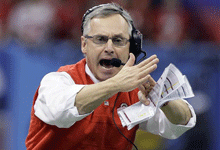Game stories don’t shake the sporting world. Stories of forced coaching changes, player misconduct, agent malfeasance and cheating of all kinds shock sports fans, drive ratings and win the biggest headlines.
But this kind of reporting comes with different challenges than the ones usually faced by sports beat reporters — magnified by the frenetic, constant sports news cycle.
Many sports reporters have never had to deal with these kinds of challenges. Sportswriters like Grantland Rice and “Red” Smith were venerated for their descriptions of games, plays and heroic athletes, not for digging into financial misdeeds, public records or systematic cheating.
But all of that has changed. Investigative reporters have turned their attention to sports, and sports reporters are faced with incidents and issues they need to investigate raising new questions about journalism values.
This was one of the topics addressed at the 2011 Poynter Kent State Media Ethics Workshop, “Foul Play,” which brought together sports professionals and media ethicists. The “Buckeyes Behaving Badly” panel examined the investigative reporting that brought down The Ohio State University football coach Jim Tressel and star quarterback Terrelle Pryor for a variety of NCAA rules violations.
-

- In this Jan. 4, 2011 file photo, then-Ohio State coach Jim Tressel signals for a timeout during the Sugar Bowl NCAA college football game against Arkansas at the Louisiana Superdome in New Orleans. Tressel was hired Sept. 2, 2011, by the Indianapolis Colts as a game-day consultant to help determine when the team should challenge plays. (Patrick Semansky/AP)
Like many teams engulfed in scandal, the Buckeyes were successful on the field; most sports reporting leading up to the scandal focused on the team’s strategy, schedule and statistics.
It was a nontraditional media outlet, Yahoo Sports, that broke the story that Tressel had covered up for Ohio State players who traded autographs and equipment for tattoos. Mainstream news organizations such as The Plain Dealer in Cleveland and The Columbus Dispatch, which were reporting on other parts of the scandal, followed Yahoo’s lead on the Tressel story.
Who digs up off-the-field scandals?
With fewer resources and a history of this sort of coverage, traditional media outlets like the Akron Beacon Journal, The Plain Dealer and the Dispatch usually focus their sports reporting on games and personalities. But without the constraints of regular game coverage, nontraditional outlets can explore off-field issues more deeply — often finding nothing of consequence, but sometimes uncovering significant news.
Because of that, fans, bloggers and Internet-only reporters are more and more likely to initially report new scandals.
As Terry Pluto, award-winning sports columnist and blogger for the Plain Dealer, and Columbus Dispatch investigative reporter Mike Wagner explained, the newspaper’s staff cannot — and did not want to — trail all the professional and collegiate athletes, not to mention the athletic directors, coaches, recruiters, trainers, doctors, marketers and everyone else associated with the game.
“If following the players to the tattoo parlor is part of the job, newspapers should hire 14 private detectives,” Pluto said. He likened it to the Plain Dealer’s crime coverage: “We aren’t on the corner waiting for someone to get murdered.”
Investigative reporting is usually a three-act play, and the Ohio State scandal was no different. First comes the initial discovery. Then the digging that broadens the issue. And finally comes the wrap-up, often resulting in punishment.
The pattern holds for other recent sports scandals. Earlier this year North Carolina State University fans on the sports message board Pack Pride uncovered extensive plagiarism by Michael McAdoo, a defensive-end for rival University of North Carolina at Chapel Hill. These fans pored through documents gathered and posted by The News & Observer, which didn’t look closely at what it had posted until the fans had identified plagiarized passages and a blogger picked up on it.
How to balance accuracy and speed while digging in
In an ongoing investigation like the Ohio State tattoo scandal, it is critical to maintain credibility while building momentum for the investigation. For the Dispatch, that meant shifting the coverage from the sports staff to Wagner, an investigative reporter.
“I approach sourcing like a prosecutor or criminal attorney,” Wagner said. “I need to make sure that [sources or documents] are credible.”
Frequency and speed can trump depth and credibility in a fast-moving environment with lots of competition.
And nontraditional news sources can push traditional media to cover stories they might not otherwise. When Deadspin reported the details of Brett Favre’s failed seduction of Jets game-day host Jenn Sterger, mainstream outlets like ESPN were quick to follow — not exactly reporting the sordid story itself, but the “news” that Deadspin had reported it.
What long-term access risks are worth breaking an important story?
Traditional media know they risk their access — press credentials, courtside seats, relationships with teams — when they dig into unpopular stories. Most bloggers and fans don’t face this problem.
Relationships with teams can conflict with or intensify the need for accuracy, if journalists personally like the subjects of the investigation; all the panelists said they respected Tressel as a person. And they knew their audience venerated the coach and the program.
Relationships between athletes and the media are changing, which has further complicated the reporting process.
None of these challenges are likely to disappear. And with so much at stake, coaches and athletes will continue to be tempted to break rules — requiring even more watchdog coverage.
Jan Leach, a journalism professor at Kent State University, contributed to this article.







Comments